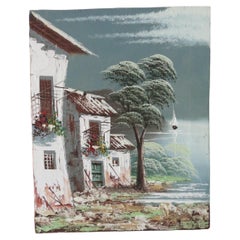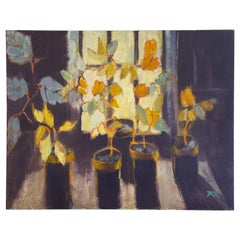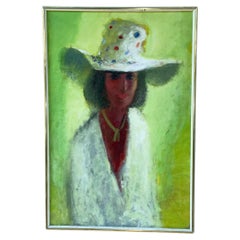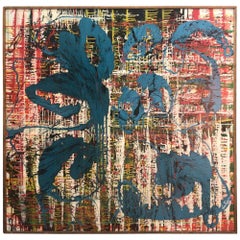Bertina lopes oil on canvas
dated and signed in the front and back
1998 Caleidoscopio
Bertina Lopes was a world famous artist. She was born on July 11, 1924, in Maputo, formerly Lourenço Marques, the capital city of Mozambique. Her mother belonged to a distinguished local family, while her father was a Portuguese colonist who worked in the field of commerce.
The artist and her three sisters received a strict scholastic education. At the same time, her dynamic family environment stimulated her precocious artistic disposition and her sense of justice and freedom that influenced her personal, ideal and artistic choices.
She attended school in Maputo, but, after her second year of senior high school, she moved to Lisbon to complete the secondary school. Here she began to study painting and drawing with Lino António and Celestino Alves.
Between 1945 and 1949, she attended a course in “Desenhador Litógrafo e Pintura Decorativa” (Litograph design and decorative painting) at “Escola de Artes Decorativas António Arroio” ("António Arroio School of Decorative Arts"), where she got a degree and an Arts Teacher Training. She also attended a painting course at “Escola Superior de Belas-Artes de Lisboa” ("University of Arts of Lisbon"). In Lisbon, she got in contact with famous painters and intellectuals of the period, like Carlo Botelho, Albertina Mantua, Costa Pinheiro, Júlio Pomar and Nuno Sampayo.
During that period, Bertina was mainly influenced by Avant-garde painting of Portuguese Modernism. The art exhibitions of important western painters and South American graffiti artists, organized by the National Society of Fine Arts (1946-56), deeply influenced the artistic background of Bertina Lopes and the other young artists of the period.
During those days, the cultural and artistic atmosphere in Portugal was afflicted by the suffocating narrow-mindedness of Antonio Salazar’s government that affected in particular the production of “arte negra” (black art).
In that atmosphere, Bertina joined antifascist circles. These political circles were inspired by Marxist and liberal ideals. There, she met many political leaders of the clandestine opposition and she incubated a strong feeling of freedom and democracy. She openly declared her communist inclinations and so the secret police kept her under strict control.
In 1953 she returned to Mozambique where she taught “Artistic Drawing” at “General Machado Girls’ Technical School” for nine years. She also taught “Artistic Drawing” and “Decorative Painting” at African Association center.
She was very popular among students for her innovative teaching, based on the observation of urban, social and natural environment, and for the feeling of freedom of her aesthetic and political ideas, but her teaching came into conflict with the strict school rules.
In 1956 she made a mural painting into the “Pavilhão da Evocação Històrica” of the “Exposiçao de Actividades Sociais, Culturais e Economicas”, opened in conjunction with the visit in Mozambique of general Craveiro Lopes, President of the Republic of Portugal. In 1959 she was nominated President of the “Secção des Artes Plàsticas” of “Nùcleo de Arte” of Maputo. She was also nominated Vice President of “Direccao” of “Nùcleo de Arte” in 1960.
In that period the artist had some political problems. In those years, Lopes met the most important protagonists of Mozambican anticolonial fight, such as Edoardo Mondane, founder of FRELIMO (Frente de Liberaçao do Moçambique), and Samora Machel, that was going to be the President of the Republic of Mozambique. She also met a lot of important artists and intellectuals that were going to play a key role in the future of Mozambique.
In those days, Bertina began to be interested in poetry. She especially liked Noémia de Sousa and José Craveirinha that influenced her artistic sensibility and her ideal motivations.
She married Virgilio de Lemos (Ibo, 1929), one of the most important poets of Mozambique. In 1955 they had two twin sons, Virgilio and Eugenio. During those years, de Lemos published, under the heteronym of Duarte Galvão, an anticolonial poem that caused him a trial for desecration of the Portuguese flag (1954). After that, he joined the Mozambican Resistance (1954-61). He was also accused and arrested for “subversion” and for his collaboration with the clandestine groups that fought for the independence of Mozambique.
The influence of her husband and of her friends strengthened Bertina’s political believes on people’s liberation from colonial oppression and from racial, social and cultural discrimination. These ideas were connected with the colonial invasion of Africa that caused exploitation and pains. She also felt an innate spirit of sympathy with the humble, the oppressed and the weak that are the subjects of a lot of her artworks of that period.
In 1961, she was forced to leave Mozambique and so she returned to Portugal where she could live and paint thanks to Victor de Sa Machado, head of Calouste Gulbenkian Foundation in Lisbon, who gave her a scholarship. In 1962 her two sons joined her and they moved to Cascais, while her husband escaped from Mozambique and hardly reached Paris.
From a stylistic point of view, Lopes’ artworks of that period are characterized by a strong ethnical sensibility that was going to return in her Roman years (1960s-1970s), while the subjects are based on African fairy-tales and stories, José Craveirinha’s poems and the political and social events of that period. During the years of her voluntary exile these subjects represented new expressive mythologies and a cry of opposition and action toward independence.
In Lisbon she met Manuel de Brito, head of Galeria III, who introduced her to a lot of artists and intellectuals. He also helped her examine the stylistic and conceptual novelties of avant-garde painting. As a matter of fact, from a visual point of view Bertina’s figuration was more and more influenced by avant-gardes that she developed through a daring employment of color and a use of line completely influenced by post-cubist deconstructivism. These two elements represent a fil rouge upon which Lopes built her artistic catalogue. In 1963 Bertina began to make pottery with Querumbin Lapa at Fábrica
Viùva Lamego...



